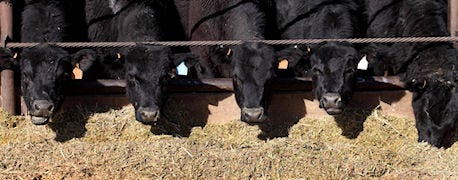April 16, 2015

If you're thinking about implementing a livestock baleage feeding system, Patrick Gunn, ISU Extension cow-calf specialist, and Joe Sellers, ISU Extension beef program specialist, have six ways you can ensure the quality of your baleage.
Related: When to turn beef cattle out on spring pasture
In the Midwest, the primary factor that influences quality of harvested dry forage is weather, Gunn and Sellers write for the April Growing Beef newsletter.

Iowa State Specialists discuss implementing a proper livestock baleage feeding system
In many instances, wet spring weather delays first cutting, resulting in mature hay that is decreased in quality, palatability, and digestibility. If harvest is not delayed, often times the window of opportunity for optimal drying is reduced, resulting in hay that is baled either too wet, or after it has been rained on, again, resulting in reduced quality at the time of feeding.
In both of these circumstances, reduced hay quality and palatability will likely lead to increased waste at the feeder, particularly if bales have been stored outside, Sellers and Gunn write.
Proper implementation of a baleage feeding system can overcome many disadvantages of first-cutting dry hay including poor nutritional quality, dry matter loss, and waste. However, improper baleage production likely will result in a very poor return on investment.
Therefore, consider these six best practices when making baleage:
1. Proper implementation of a baleage feeding system can overcome many disadvantages of first-cutting dry hay including poor nutritional quality, dry matter loss, and waste. However, improper baleage production likely will result in a very poor return on investment. Therefore consider the following practices when it comes to making baleage: Moisture: Bales should be 50-60% (or 40-50% DM).
2. Quality: Plant sugar is a requirement for ensiling, so utilizing good quality standing forage is better. Forage that has been rained on after cutting, as well as excessively mature standing forage that has reduced plant sugar will not optimize the ensiling process. A wise man once said, "You can't make chicken salad out of chicken poop."
Related: Texas bermudagrass pasture study says nitrogen fertilizer not essential
3. Size: Larger bales result in less total plastic needed to store the entire crop. However, given the moisture content, bales can quickly become larger than equipment at many operations can handle.
~~~PAGE_BREAK_HERE~~~
4. Baler: Be sure the baler is capable of making an extremely tight bale. Oxygen is the enemy when it comes to ensiling and too "loose" of a bale can lead to mold, among other problems. Thus, the tighter the bale the better. Having a baler that is capable of chopping the forage (i.e. "silage special" package) to reduce particle size will help considerably when working with taller, more mature forages.
Set The Schedule For Hay Quality. Deciding when to make the first cutting of hay sets the stage for the rest of the year. Download our FREE report 10 Hay Farming Basics: Producing A Quality Hay Product today.
5. In-line vs. individual wrapping: Which is better for your operation? Typically, in-line will use less total plastic and thus be more economical purely from a wrapping perspective. However, logistical issues may make individual wrapping a better choice for some operations.
6. Baleage vs. haylage: Again, which is more appropriate for your operation? If the final product will be close to the feeding area, bagged haylage may be a cheaper, more viable option if you are equipped with an area to properly feed loose forage. However, if ring feeders are the preferred delivery system and/or forage will have to be moved a considerable distance to be fed, baleage may be the better option.
The Growing Beef Newsletter is produced by the Iowa Beef Center at Iowa State University.
You May Also Like




